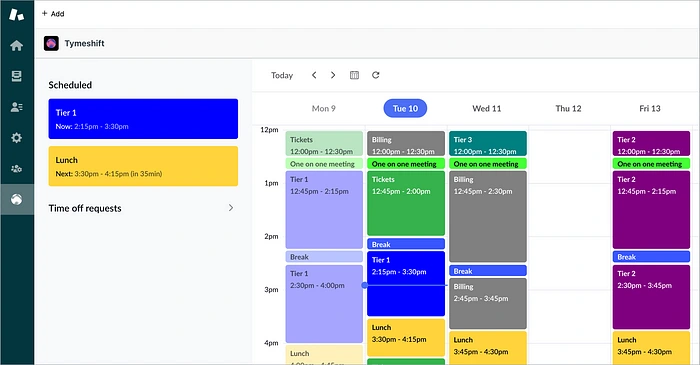Integrating Support into the Company Vision

Integrating Support into the Company Vision — Beyond the Queue
·
4 min read
·
6 days ago

Introduction
Keeping clients and customers happy is the main goal of the customer support team for many organizations. Support teams are responsible for handling tickets, emails, phone calls, chat messages, social media posts, and more! However, what if we shifted our focus from a queue-centered mindset to aligning the support team more closely with the company’s vision? This shift could unlock the full potential of support teams, making them more than just reactive problem-solvers.
In this blog post, we’ll explore key strategies to integrate support into the broader company vision: leveraging Zendesk Workforce Management (WFM), implementing OKRs, and fostering cross-functional collaboration.
Rethinking the Support Team’s Role in the Business
“Customer service shouldn’t just be a department, it should be the entire company.” — Tony Hsieh
I love this quote because it highlights the need for every team to understand the customer journey, not just the frontline support team. Support teams have direct insight into day-to-day customer interactions and can provide valuable feedback that often goes unnoticed by other departments. Leadership should view support not as a queue of tickets but as a wealth of information that can shape business strategy.
If support teams are confined to just resolving inquiries, their potential for growth and contribution is limited. As a manager, I often ask: “What can my team do in their current role that will provide them with growth opportunities within the company?”
The answer: Support teams can transition into various roles, including account management (customer success), sales, marketing, engineering, product development, and more.
Leveraging Zendesk WFM to Optimize Workloads

I get it—support teams were hired to handle inquiries, and depending on the volume, every hand may be needed. However, the right tools can help balance efficiency and engagement.
“Zendesk Workforce Management (WFM) balances efficiency and engagement by leveraging AI to automate forecasting and scheduling, optimize resource allocation, improve productivity, and enhance employee experience through real-time data and tools for continuous feedback and learning.”
For the sake of familiarity, I’ll focus on Zendesk WFM, though there are many excellent workforce management tools available. The goal is to carve out time for support reps to engage in activities beyond the queue — cross-functional collaboration, special projects, and upskilling.
Pro Tip: Use WFM data to create reports that highlight trends in customer issues and agent productivity. This information can support business decisions across departments.
Connecting Support Work to Company OKRs

OKRs (Objectives and Key Results) should be more than a managerial checkbox — they should be actively understood and applied across all teams, including support.
Examples of Support-Focused OKRs:
Product, Support, and Marketing: Reduce churn by X% through proactive customer education.
Product, Support, and Account Management: Improve response times to increase customer satisfaction scores.
Product, Support, and Engineering: Escalate and analyze customer insights to shape product development.
OKRs should be reviewed regularly, not just set and forgotten. A strong OKR strategy ensures that the support team’s contributions are recognized and maximized.
Actionable Tip: Hold quarterly OKR review sessions, during which support teams present insights from their customer interactions to leadership and other departments.
Encouraging Cross-Functional Collaboration

Cross-functional collaboration must be intentional. Support teams hold invaluable insights, and it’s essential to create opportunities for them to contribute.
Example Cross-Functional Projects:
Product Development: How is the support team’s customer feedback influencing the product roadmap?
Marketing: How can support reps contribute to self-service content based on FAQs and common inquiries?
Sales & Onboarding: How can support insights improve the post-onboarding customer experience?
Engineering: Is an issue a bug or a feature? How can support and engineering teams collaborate to create sustainable fixes?
Account Management: How can support ensure that unresolved customer issues are addressed beyond weekly stakeholder calls?
Best Practices for Fostering Collaboration:
Dedicated Slack (or messaging platform) channels for interdepartmental support discussions.
Regular cross-functional meetings where support teams share key customer insights.
Internal mentorship programs pairing support reps with employees in other departments.
Cultivating a Vision-Driven Support Culture

If leadership does not reinforce the company’s vision within support, other departments likely won’t either. Support teams should be recognized and rewarded for their contributions beyond resolving tickets.
Ideas for Real-Time Recognition:
Slack Shoutouts: Encourage leadership to celebrate support team wins publicly.
All-Hands Recognition: Leadership should proactively highlight support team contributions in company-wide meetings.
Listening Sessions: Monthly meetings where leaders listen to support team feedback and implement meaningful changes.
Financial incentives also matter. Employees are more engaged when they see a clear career path with growth and development opportunities.
Conclusion
We’ve covered a lot, and now it’s time for action. Let’s shift away from a “queue-only” mindset for support teams. This change will not only boost morale but also elevate support as a strategic function within the company.
Final Thought: Know of companies successfully integrating support into broader business goals? Share them! I’d love to learn from their successes.
Like this project
Posted Mar 23, 2025
Let’s shift away from a “queue-only” mindset for support teams. This change will boost morale & also elevate support as a strategic function within the company.






